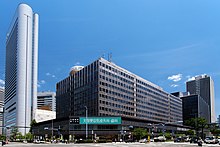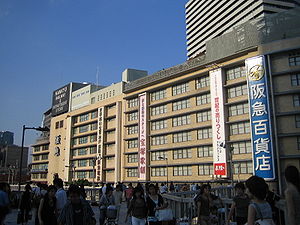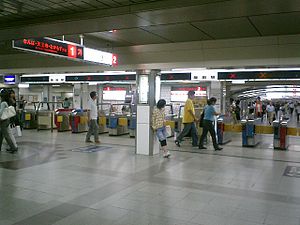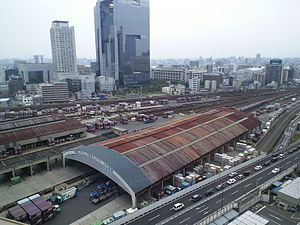|
Umeda Station
Umeda Station (梅田駅, Umeda-eki) is a major railway station in Kita-ku in the northern commercial center of Osaka, Japan. It is the busiest station in western Japan, serving 2,343,727 passengers daily in 2005.[citation needed][clarification needed] Umeda Station is served by the following railways:
The freight terminal of Japan Freight Railway Company (JR Freight) (Umeda Freight Branch of Tōkaidō Main Line), closed in 2013, was also called Umeda. Portions of this line was moved underground in 2023. The nearby stations Ōsaka (JR West), Kitashinchi (JR West Tōzai Line), Nishi-Umeda (Osaka Subway Yotsubashi Line, Y11) and Higashi-Umeda (Osaka Subway Tanimachi Line, T20) are within walking distance and connected by a large complex of underground malls. Hanshin Railway
The underground Umeda terminal of Hanshin Electric Railway (officially Osaka-Umeda Station, but commonly called Hanshin Osaka-Umeda Station) is located south of Ōsaka Station, next to underground of Hanshin Department Store. The Hanshin station first opened on December 21, 1906 as a ground level station and moved to the present underground location on March 21, 1939. LayoutThere are five bay platforms and four tracks on the second basement. There are east ticket gates on the second basement and center ticket gates and west ticket gates on the first basement.
Adjacent stations of Hanshin Osaka-Umeda
Hankyu Railway
The Umeda terminal of Hankyu Railway (officially Osaka-umeda Station, but commonly called Hankyu Osaka-umeda Station) is located northeast of Ōsaka Station. The station first opened on March 10, 1910, as a ground-level station. The original location of the station was southeast of Ōsaka Station and the Hankyu (then Minoo-Arima Electric Tramway) tracks crossed the Tōkaidō Main Line by an overpass. The station was elevated on July 5, 1926.  When Osaka Station was elevated in 1934, Hankyu's elevated tracks were forced to be removed and new Umeda Station was built to handle new ground-level tracks. The switching of tracks were carried out on June 1, 1934. This station facility was used until November 28, 1971, when the move of station to the present location was completed. This move was because of a sharp increase of transit, which forced Hankyu to operate 8-car trains. The existence of JNR tracks on the northern end of the 1934 station prevented the expansion of the station so that the station could not handle long trains. After the opening of the current huge elevated station, spaces around and beneath the station, as well as the site of former station, were extensively redeveloped. One of the symbols of the commercial complex surrounding the station is the BIG MAN video screen above the Kinokuniya bookshop, common and necessary places to meet in this bustling railway station. The Hankyu Department Store, built next to the station in 1929, was a pioneer of the successful business model of department stores run by urban railway companies in Japan. The store is still in business at the original location even after the move of the station (as of 2007, the reconstruction of the store building is in progress). Station numbering was introduced to all Hankyu stations on 21 December 2013 with this station being designated as station number HK-01.[1] LayoutThere are ten bay platforms serving nine tracks on the third floor. There are south ticket gates on the third floor and center ticket gates and on Chayamachi ticket gates on the second floor.
Adjacent stations of Hankyu Osaka-umeda
Osaka Metro
Umeda is the transferring point of three lines of the metro: the Midōsuji Line, the Tanimachi Line and the Yotsubashi Line. Among them, only the Midōsuji Line station is named Umeda, with the station number M16. The Tanimachi Line station is Higashi-Umeda (meaning "East Umeda") and the Yotsubashi Line station is Nishi-Umeda (meaning "West Umeda"). These three stations are connected with each other by underground walkways. Regular tickets of the subway, Surutto Kansai cards and IC cards are valid until the passenger gets out the ticket barrier of the station. The transfer between the three Umeda stations is an exception of this principle; the fare can be calculated as one travel as if the passengers do not exit the station provided the passengers transfer within 30 minutes.[3] Umeda Station on the Midōsuji Line started its operation on May 20, 1933, as a temporary station. The station was moved to the present location on October 6, 1935. Originally the station with an island platform and two tracks was built amid one tunnel, but on November 5, 1989, the station was expanded to a tunnel that existed next to the station (built for Tanimachi Line but due to change of plan remained unused for decades). The two tunnels are separated by a wall with some passages. Layout
Japan Freight Railway
Umeda Freight Terminal of Japan Freight Railway Company (JR Freight) was a freight terminal on the Umeda Branchline (unofficial name) of the Tōkaidō Main Line owned by West Japan Railway Company (JR West). The station was built to separate freight services from Ōsaka Station and began operation on December 1, 1928.[4] The yard of the terminal was located to the north, literally in the backyard, of the Ōsaka Station. The freight terminal ceased to handle freight on March 16, 2013 and its function was succeeded by newly established Suita Freight Terminal and other nearby yards.[5] The station was officially closed on March 31, 2013.[6] The site, commonly called Ōsaka Station North Area (ja:大阪駅北地区, Ōsaka-eki Kita-chiku) or Ume-kita (うめきた), will be redeveloped.[7] A portion of the line was moved underground in 2023, resulting in an addition of underground passenger platforms at Ōsaka Station which was previously bypassed. The JR West Limited Express trains still use the freight line to transfer from the Osaka Loop Line to the JR Kyoto Line. No passenger trains had stopped at Umeda Freight Station itself.
Surrounding area  
See alsoReferences
External linksWikimedia Commons has media related to Umeda Station. |
||||||||||||||||||||||||||||||||||||||||||||||||||||||||||||||||||||||||||||||||||||||||||||||||||||||||||||||||||||||||||||||||||||||||||||||||||||||||||||||||||||||||||||||||||||||||||||||||||||||||||||||||||||||||||||||||||||||||||||||||||||||||||||||||||||||||||||||||||||||||||||||||||||||||||||||||||||||||||||
















